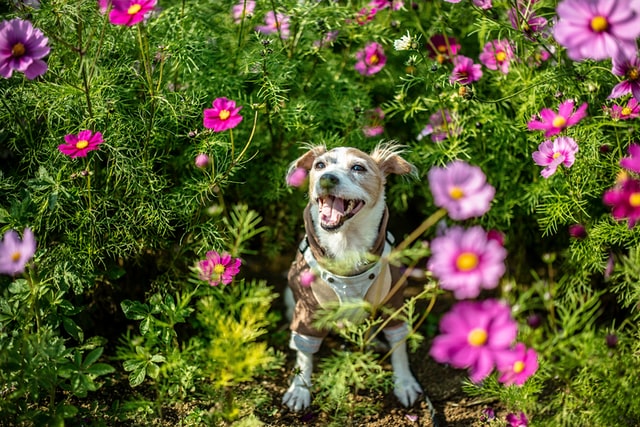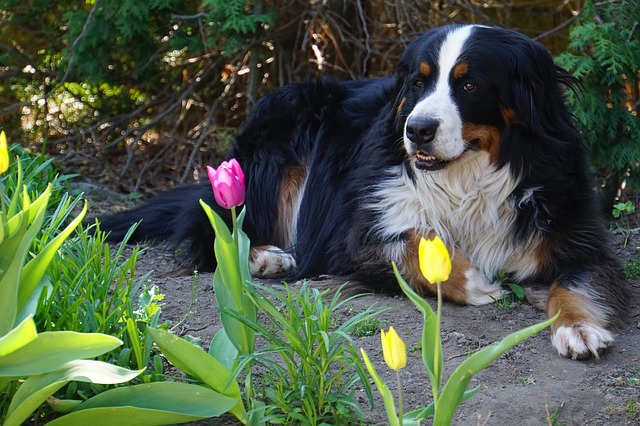5 Spring Safety Tips for Dogs
Posted: 11/06/2023 | BY: Erin Cain | Categories: Uncategorized
It’s springtime, a cause for joyful celebration, especially for those families who have spent the winter in cold and snowy climates. After the turbulent year the world has experienced, people — and their furkids — are looking forward to spending more time outside. Although spring is a time associated with hope and renewal, it can also spell disaster for your pup. Here are 5 spring safety tips for dogs to know before you and your dog embrace the new season.
1. Avoid bugging out with fleas, ticks, and mosquitos.
Warmer temperatures bring grass growth and flowers and bugs. Soon, fleas, ticks, and mosquitos will be setting up shop in your lawns and garden…and on your dog. You can stop these pests from biting and infecting your pup through year-round preventative measures.
For example, heartworm disease spreads to dogs through a mosquito bite. Without medical attention, heartworm disease can eventually lead to heart failure in a dog.
Talk to your veterinarian about which parasite and insect brand and dosage are right for your dog. Dogs on preventatives for ticks, fleas, and mosquitos are much safer from the dangers associated with these bugs during spring and summer.

2. Don’t stop and sniff the flowers.
Blooming flowers are a sure sign of springtime, but some plants and garden control products are toxic to canines. From calla lilies to boxwoods to showy daisies, many plant varieties can harm your dog. Check out the ASPCA’s complete list of plants toxic to dogs to check what plant dangers may lurk in your garden.
Spring is also a time for people to spruce up their lawns. Be aware that herbicides, pesticides, and fertilizers can be harmful to your pup. Severe gastrointestinal and respiratory difficulties are initial symptoms of exposure, but a recent study shows that exposure to pesticides can cause bladder cancer in dogs.
Keep your dog off of treated lawns for the 48-hour minimum required. Wash your dog’s paws for up to a week after the lawn treatment. Try to prevent your dog from eating treated grass during this time as well. If you are afraid your dog has ingested a toxic plant, contact your veterinarian or the 24/7 Animal Poison Control Center for immediate assistance.
3. Steer your pup clear of household cleaning products.
Spring cleaning fever is in the air, but all of those household cleaning products you use around your house are dangerous for your dog. Even products labeled “natural” may not be entirely safe. Bleach, furniture polish and cleaners, carpet cleaners, and pool chemicals are toxic to canines. Keep your dog out of the areas you are cleaning with these products until they are completely dry. Always keep your household cleaners locked away and out of reach of any pets. You can find some reasonably priced pet-safe cleaners online or in stores, or you can make your own safe cleaning products.

4. Watch out for bee stings.
Although they are not as common as people may think, bee stings can cause trouble for dogs. Stings typically happen on a dog’s face, nose, or paw pads, generally the three areas most likely to come in contact with springtime bees. You can treat your dog’s bee sting at home by removing the stinger and applying a cold compress or pack to the swollen area. Contact your veterinarian before putting any ointment on the wound.
Some dogs are highly allergic to bee stings, so if your pup is experiencing extreme swelling or having a difficult time breathing, take her to the veterinarian immediately. Severe allergic reactions may cause your dog to go into anaphylactic shock, where her throats swell shut, threatening her life.

5. Save the slugs and your pup.
Slugs and snails may be common inhabitants of your yard, but they are also carriers of the lungworm parasite. When a dog eats an infected slug, the parasite makes its home in the dog’s lungs to lay eggs that hatch in the lungs’ small sacs (bronchi). This infection of the respiratory system can cause a series of reactions, from coughing and wheezing to lethargy and an increased respiratory rate, even at rest. Dogs with lungworm need a veterinary diagnosis and treatment with a specific anti-parasitic medicine, as well as nebulizers or steroids.
Avoid commercial slug and snail baits as most contain metaldehyde, a toxin that may cause seizures and other neurological symptoms in dogs if they lick or eat these bugs. Use pet and environment-safe products, such as diatomaceous earth, to keep slugs and snails out of your lawn and garden.
BONUS Tip – Look Out for Those Seasonal Allergies
People aren’t the only ones that can suffer from springtime allergies. Our dogs can also have environmental allergies to things like pollen, weeds, grass and flowers. Watch to see if you think your dog is being triggered by one or more of these common allergens. But you’ll need to know what to look for.
You see, while humans may experience allergy symptoms such as a runny nose, itchy eyes, and sneezing, dogs experience allergies very differently. Our pups experience intense skin issues. Common hot spots include their paws, groin, wrists and the base of their tail. They may also rub their ears and eyes. Watch to see if your dog is licking, scratching or biting himself more than usual. You may even notice some patchy hair loss in places from constantly licking and chewing. if you notice any of this, you’ll want to bring your pup in to see the vet, who can recommend allergy treatment options.
Springtime emergency? Pet insurance can help.
Pets are ingenious when it comes to getting a hold of products and materials and bugs that they should leave well enough alone. Sometimes, no matter how much you dog-proof your home and yard, springtime trouble comes calling. Make sure your pet has a pet insurance policy to help cover unplanned medical emergencies. Not sure where to start? Pet Insurance Review can help. Fill out our form for a free pet insurance quote, and be prepared for any seasonal issues your dog may face.
References:
- VDCI. (2021). What is Heartworm Disease and How Does it Spread? Retrieved from https://www.vdci.net/vector-borne-diseases/heartworm-disease-dog-and-cat-education-and-integrated-mosquito-management-to-protect-public-health/
- ASPCA. (2021). Poisonous Plants. Retrieved from https://www.aspca.org/pet-care/animal-poison-control/toxic-and-non-toxic-plants/a?field_toxicity_value%5B01%5D=01&
- DesCamps, M. (2018). What Happens When a Dog Rubs on Pesticide-Treated Grass? Retrieved from https://homeguides.sfgate.com/happens-dog-rubs-pesticidetreated-grass-87365.html
- Pet Poison Hotline. (2021). 24/7 Animal Poison Control Center. Retrieved from https://www.petpoisonhelpline.com
- Marlowe Leverette, M. (2021). The 5 best pet-safe cleaning products for your home in 2021. Retrieved from https://www.businessinsider.com/best-pet-safe-cleaning-products
- Furchild Pet Nutrition. (2021). 8 DIY Homemade Cleaners that are Safe for Pets. Retrieved from https://furchildpets.com/blog/8-diy-homemade-cleaners-that-are-safe-for-pets
- Elfenbein, H. (2020). What to Do If Your Dog is Stung By a Bee. Retrieved from https://www.greatpetcare.com/dog-health/all-about-dog-bee-stings/
- Evans, J. (2018). What Happens If Your Dog Eats A Slug? Retrieved from https://smartdogowners.com/slugs-and-lungworm-in-dogs/
- Barnette, C. (2021). Metaldehyde Toxicity (Slug Bait Poisoning). Retrieved from https://vcahospitals.com/know-your-pet/metaldehyde-toxicity-slug-bait-poisoning
- Knerl, L. (2017). How to Use Diatomaceous Earth for Pest Control. Retrieved from https://gardenerspath.com/how-to/disease-and-pests/diatomaceous-earth/
Disclaimer
The information contained on this blog is intended for informational and educational purposes only and should not be construed as medical advice. It is not a substitute for professional veterinary care. Always consult with your veterinarian before making any changes to your pet's health care or treatment plan.
The authors of this blog are not veterinarians and do not claim to be experts in pet health. The information provided here is based on our own experiences and research, as well as information from reputable sources. However, we cannot guarantee the accuracy or completeness of this information.
We encourage you to do your own research and consult with your veterinarian before making any decisions about your pet's health.
Previous post
Heat Stroke in Dogs: Treatment and PreventionNext post
Best Dog Breeds for Apartment LivingCompare top pet insurance providers plans.
Enter your dog’s age in years and months to calculate their age equivalent to human years.
Calculate your dog’s ageEnter your cat’s age in years and months to calculate their age equivalent to human years.
Calculate your cat’s age